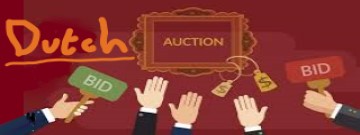
A Dutch Auction is an auction in which the auctioneer begins with a high asking price, and lowers it until some participant accepts the price, or it reaches a predetermined reserve price. This type of auction is good for auctioning goods quickly, since a sale might never requires more than one bid for a single lot, or instances where a large quantity of a given item is being offered for sale, as opposed to just a single item. The company works down the list of bidders until the total desired number of items are sold.
A Dutch Auction is sometimes known as a “clock auction”, an “open-outcry descending-price auction” or a “uniform price auction”. The term is often confused and used interchangedly with Dutch Tender.
Dutch Auction Example
The Federal Reserve Bank of New York (FRBNY) is responsible for raising funds for the U.S. Government by way of a Dutch auction. The FRBNY contacts large banks and broker-dealers who submit bids. These can be on behalf of themselves or an investment for their clients.
Let’s suppose the issuer seeks to raise $1 billion in thirty-year bonds (T-bills could also be used) with a 4.500% coupon. The aggregate bids are as follows:
- $100 million at 4.490% – highest bid
- $225 million at 4.495%
- $375 million at 4.500%
- $450 million at 4.505%
- $350 million at 4.510%
- $200 million at 4.515% – lowest bid
In this example, $300 million of the 4.505% is required to complete the sale. This means the bids above will be filled in their entirety, whilst two-thirds of the 4.505% bid will be filled. The bids below that will receive nothing. This auction is said to clear at a yield of 4.505%. All successful investors, or bidders pay the same amount. The theory is that this feature of the Dutch auction will lead to more aggressive bidding. Those who bid 4.490% receive the bonds at the higher yield (lower price) of 4.505%.
